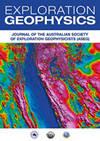边钻边震:用冲击钻作为能源的基本实验
IF 0.8
4区 地球科学
Q4 GEOCHEMISTRY & GEOPHYSICS
引用次数: 11
摘要
我们讨论了利用冲击钻作为能源进行SWD(地震随钻)调查的可行性。该钻井技术具有安全、经济、快速的特点,在钻井行业得到了广泛的应用。对于社会福利署的测量,一个宽广的源频谱是必不可少的;然而,通常冲击钻井产生的地震信号的频率含量主要受钻头的冲击速率控制,具有严重的频带限制。在本文中,我们报告了扩大冲击钻的频谱能量输出的尝试。冲击钻信号的频率含量可以通过在钻井过程中手动改变液压输入来控制。由于液压压力的变化会影响冲击功率和钻井速度,从而导致钻井振动频率的变化。我们表明,处理后的响应与传统的射击记录相当,但冲击钻和互相关方法仍然需要改进,才能被认为与传统数据相等。本文章由计算机程序翻译,如有差异,请以英文原文为准。
Seismic While Drilling: Basic Experiments Using a Percussion Drill as an Energy Source
We discuss the feasibility of performing SWD (Seismic While Drilling) surveys utilizing a percussion drill as an energy source. This drilling technology is widely used in the drilling industry because it enables safe, economical, and rapid drilling. For SWD surveys, a broad source frequency spectrum is essential; however, the frequency content of seismic signals normally generated by percussion drilling is severely band limited because it is primarily controlled by the impact rate of the drill. In this paper, we report attempts at broadening the spectral energy output of a percussion drill. The frequency content of percussion drill signals can be controlled by manual variation of the hydraulic pressure input during drilling. Because hydraulic pressure change affects both the impact power and the rate of drilling, this results in a change in the frequency of drilling vibrations. We show that the response after processing is comparable with a conventional shot-record, but the percussion drill and cross-correlation method still requires improvements before it can be considered equal to conventional data.
求助全文
通过发布文献求助,成功后即可免费获取论文全文。
去求助
来源期刊

Exploration Geophysics
地学-地球化学与地球物理
CiteScore
2.30
自引率
0.00%
发文量
33
审稿时长
>12 weeks
期刊介绍:
Exploration Geophysics is published on behalf of the Australian Society of Exploration Geophysicists (ASEG), Society of Exploration Geophysics of Japan (SEGJ), and Korean Society of Earth and Exploration Geophysicists (KSEG).
The journal presents significant case histories, advances in data interpretation, and theoretical developments resulting from original research in exploration and applied geophysics. Papers that may have implications for field practice in Australia, even if they report work from other continents, will be welcome. ´Exploration and applied geophysics´ will be interpreted broadly by the editors, so that geotechnical and environmental studies are by no means precluded.
Papers are expected to be of a high standard. Exploration Geophysics uses an international pool of reviewers drawn from industry and academic authorities as selected by the editorial panel.
The journal provides a common meeting ground for geophysicists active in either field studies or basic research.
 求助内容:
求助内容: 应助结果提醒方式:
应助结果提醒方式:


